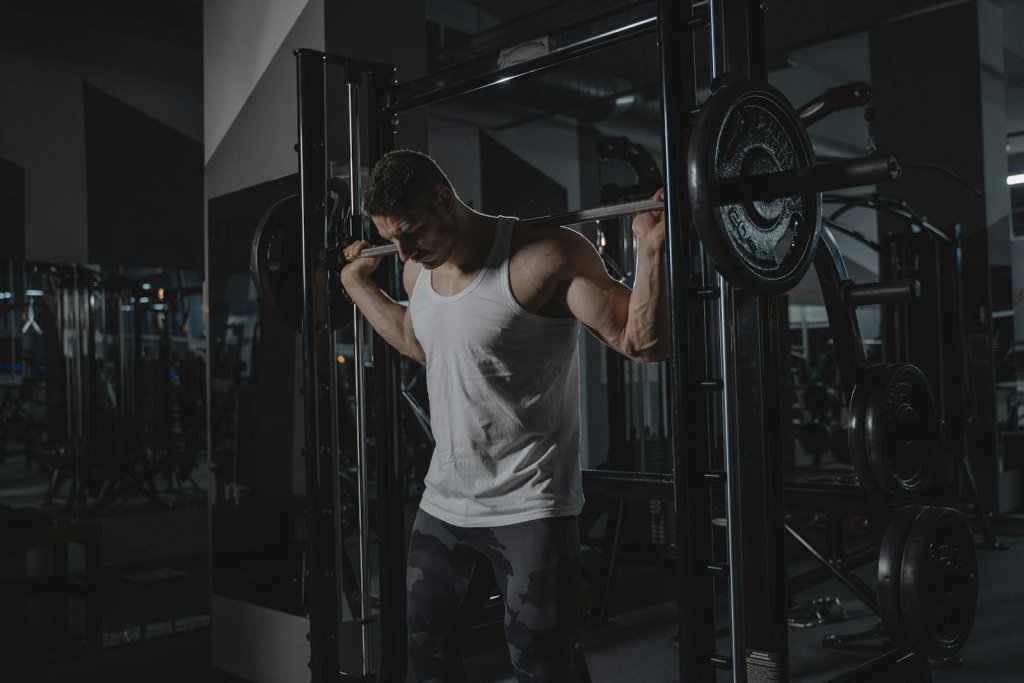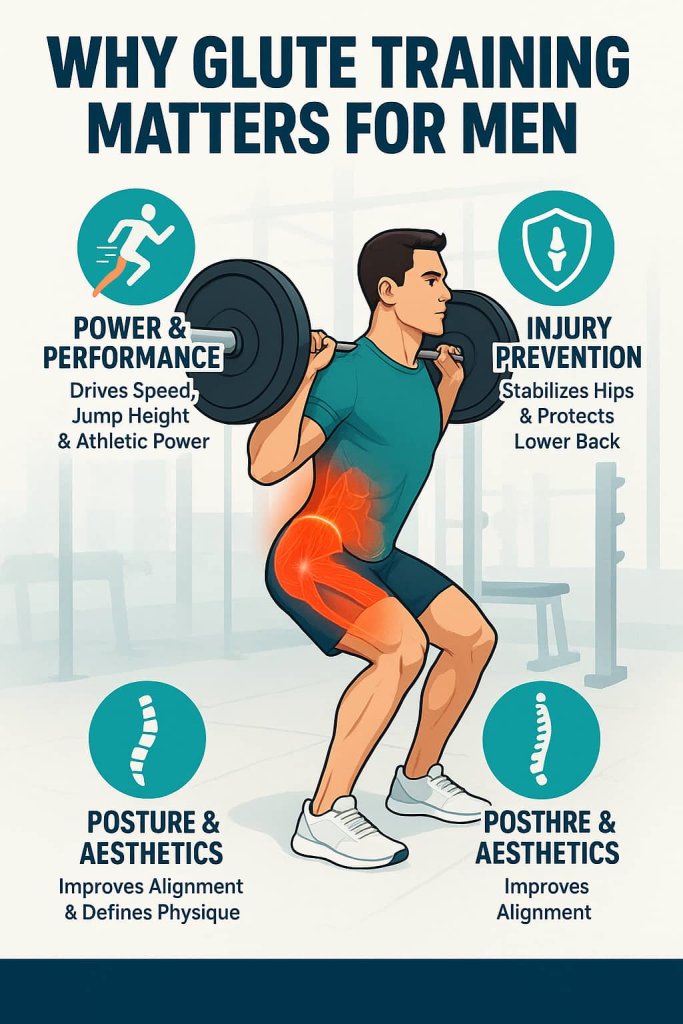The best glute exercises for men build strength, size, and athletic power by targeting all three glute muscles — maximus, medius, and minimus. Strong glutes don’t just look good — they’re essential for sprinting, jumping, lifting, and preventing back or knee pain.

Building your glutes improves performance, posture, and total-body power. This guide covers the 17 most effective, research-backed glute exercises—from strength lifts like squats and hip thrusts to stability moves for balance and definition. Each exercise is science-supported, safe, and proven to activate your glutes for visible results.
According to the National Strength and Conditioning Association (NSCA), glute-focused training should combine hip extension, abduction, and rotation for complete muscle activation.
Why Glute Training Matters for Men
Men often overlook glute training, but research shows it’s vital for:

- Power and Performance: Strong glutes drive speed, vertical jump, and athletic movement.
- Injury Prevention: Balanced glute strength stabilizes hips and knees, reducing strain on the lower back.
- Posture & Aesthetics: Proper glute development supports spinal alignment and enhances your physique.
A 2024 Journal of Strength & Conditioning Research study found that targeted glute exercises improve sprint acceleration, hip extension strength, and lower-limb stability in trained men.
17 Best Glute Exercises for Men
These 17 research-backed glute exercises help men build strength, power, and definition from every angle. Combine heavy lifts, unilateral moves, and activation drills to develop complete lower-body performance and symmetry.
1. Barbell Hip Thrust
Why it works:
One of the most effective glute-builders, the barbell hip thrust isolates and maximally activates the gluteus maximus better than squats or deadlifts. It strengthens the posterior chain and enhances lower-body power and sprint performance.
Muscles worked:
Gluteus maximus, hamstrings, core
How to do it:
- Sit on the floor with your upper back against a bench.
- Roll a barbell over your hips, knees bent, feet flat.
- Drive through your heels to lift hips until shoulders, hips, and knees form a line.
- Lower slowly and repeat for 8–12 reps.
Trainer Tip:
Pause 1–2 seconds at the top and squeeze hard for maximum glute contraction.
2. Bulgarian Split Squat
Why it works:
A unilateral powerhouse that improves balance, hip stability, and glute hypertrophy by working each leg independently.
Muscles worked:
Glutes, quads, hamstrings, core stabilizers
How to do it:
- Stand a few feet in front of a bench with one foot placed behind you.
- Lower your back knee toward the floor until your front thigh is parallel.
- Push through your front heel to rise back up.
Trainer Tip:
Lean slightly forward to keep tension on the glutes instead of the quads.
3. Romanian Deadlift (RDL)
Why it works:
Emphasizes the glute-hamstring connection through hip hinging, improving strength and flexibility in the posterior chain.
Muscles worked:
Gluteus maximus, hamstrings, erector spinae
How to do it:
- Hold a barbell or dumbbells in front of your thighs.
- With a slight bend in your knees, hinge at your hips until your torso is nearly parallel to the floor.
- Drive hips forward to return to standing.
Trainer Tip:
Keep the bar close to your shins to protect your lower back.
4. Barbell Back Squat
Why it works:
A total-body strength builder that engages the glutes heavily at deeper ranges of motion, promoting hypertrophy and power.
Muscles worked:
Glutes, quads, hamstrings, lower back, core
How to do it:
- Position the barbell across your upper traps.
- Lower your hips until thighs are at least parallel to the floor.
- Drive through your heels to stand tall.
Trainer Tip:
Squat below parallel for maximum glute engagement.
5. Step-Up
Why it works:
Builds single-leg strength and coordination while developing glute power through full hip extension.
Muscles worked:
Glutes, hamstrings, quads
How to do it:
- Step one foot onto a sturdy bench or box.
- Push through your heel to lift your body.
- Lower under control and switch sides.
Trainer Tip:
Hold dumbbells for increased resistance and stability.
6. Walking Lunge
Why it works:
Promotes hip flexion and extension with every stride, effectively activating the glutes through a deep range of motion.
Muscles worked:
Glutes, quads, hamstrings, core
How to do it:
- Step forward into a lunge, lowering your back knee toward the floor.
- Push through your front heel to move forward into the next step.
Trainer Tip:
Take longer strides to shift emphasis from quads to glutes.
7. Cable Kickback
Why it works:
Provides constant tension through the range of motion to isolate and sculpt the gluteus maximus.
Muscles worked:
Gluteus maximus, hamstrings
How to do it:
- Attach an ankle strap to a low pulley.
- Keeping your torso stable, kick one leg back and slightly upward.
- Squeeze at the top before returning slowly.
Trainer Tip:
Perform controlled reps — avoid using momentum.
8. Dumbbell Deadlift
Why it works:
Combines balance and strength, engaging glutes deeply with less spinal stress than the barbell version.
Muscles worked:
Glutes, hamstrings, lower back
How to do it:
- Hold dumbbells at your sides.
- Hinge at the hips until dumbbells reach mid-shin level.
- Return to standing by driving hips forward.
Trainer Tip:
Keep your spine neutral and core braced throughout.
9. Single-Leg Glute Bridge
Why it works:
Targets each glute independently and improves pelvic stability — key for athletes and balance.
Muscles worked:
Glutes, hamstrings, core
How to do it:
- Lie on your back with one knee bent and the other leg extended.
- Lift hips by pressing through your grounded heel.
- Lower slowly and repeat.
Trainer Tip:
Hold at the top for 2 seconds each rep to increase tension.
10. Sumo Deadlift
Why it works:
The wide stance increases hip abduction, engaging the glutes and inner thighs more than the conventional deadlift.
Muscles worked:
Glutes, hamstrings, adductors, lower back
How to do it:
- Stand with a wide stance, toes slightly outward.
- Grip the bar inside your knees.
- Drive through your heels to lift and lock out at the top.
Trainer Tip:
Keep chest up and knees tracking over toes for safety.
11. Kettlebell Swing
Why it works:
A dynamic exercise that trains explosive hip extension — ideal for athletic power and glute endurance.
Muscles worked:
Glutes, hamstrings, core
How to do it:
- Hold a kettlebell with both hands between your legs.
- Hinge at the hips, then explosively thrust forward to swing the bell to chest height.
Trainer Tip:
Let your hips, not your arms, generate the movement.
12. Side-Lying Leg Raise
Why it works:
Isolates the gluteus medius for better hip stability, balance, and side definition.
Muscles worked:
Gluteus medius, minimus, obliques
How to do it:
- Lie on one side with legs stacked.
- Raise your top leg as high as possible without rotating your hips.
Trainer Tip:
Use a mini resistance band for added load.
13. Banded Lateral Walk
Why it works:
Activates and strengthens the smaller glute muscles responsible for hip stability and knee alignment.
Muscles worked:
Gluteus medius, minimus
How to do it:
- Place a resistance band above your knees.
- Get into a partial squat and step sideways for 10–12 steps.
Trainer Tip:
Keep consistent tension on the band — don’t let your knees cave inward.
14. Frog Pump
Why it works:
Emphasizes lower glutes while minimizing hamstring involvement; excellent for endurance and burnout sets.
Muscles worked:
Gluteus maximus, medius
How to do it:
- Lie on your back with soles together and knees out.
- Drive hips upward, squeezing glutes at the top.
Trainer Tip:
Perform 15–20 reps for a high-burn finisher.
15. Reverse Lunge
Why it works:
Reduces knee stress compared to forward lunges while focusing on the glutes and hamstrings.
Muscles worked:
Glutes, hamstrings, quads
How to do it:
- Step one leg backward into a lunge position.
- Push through the front heel to return to standing.
Trainer Tip:
Maintain an upright torso and add dumbbells for extra challenge.
16. 45-Degree Back Extension
Why it works:
Targets glutes and spinal erectors through controlled hip extension; builds posterior-chain endurance.
Muscles worked:
Glutes, lower back, hamstrings
How to do it:
- Secure your feet under the pads of a hyperextension bench.
- Lower your torso to about 45° and raise back up using your glutes.
Trainer Tip:
Avoid hyperextending — stop when your body is in a straight line.
17. Glute March (Hip Thrust Hold)
Why it works:
Improves core stability and glute endurance by challenging single-leg strength under load.
Muscles worked:
Gluteus maximus, medius, core
How to do it:
- Hold the top of a hip thrust with hips fully extended.
- Alternately lift each foot off the floor while maintaining hip height.
Trainer Tip:
Focus on even hip control — avoid letting one side drop.
How to Structure Your Glute Workout
- Frequency: 2–3 times per week
- Sets/Reps: 3–4 sets of 8–12 reps (heavy lifts), 15–20 reps (bodyweight moves)
- Rest: 60–90 seconds between sets
- Progression: Increase weight or reps weekly
- Split Example:
- Day 1 – Strength (Hip Thrusts, Squats, Deadlifts)
- Day 2 – Unilateral (Lunges, Step-Ups, Bridges)
- Day 3 – Stability & Burnout (Bands, Leg Raises, Marches)
Common Mistakes to Avoid
- Using quads instead of glutes during lifts
- Doing partial reps and limiting range of motion
- Skipping single-leg (unilateral) exercises
- Poor hip hinge or squat form
- Not increasing weight or reps over time
- Skipping warm-up or activation drills
- Training too often without recovery
FAQs
1. Do men really need glute training?
Yes. Strong glutes enhance performance, posture, and injury prevention — not just aesthetics.
2. Can glute workouts improve testosterone or muscle growth overall?
Compound lifts like squats and deadlifts boost hormonal response and total muscle gain.
3. How long before results appear?
With proper nutrition and progressive overload, visible results often appear in 6–8 weeks.
4. Should I train glutes if I already do leg day?
Yes. Standard leg days often under-train glutes — add hip thrusts and bridges for balance.
5. Can I train glutes at home?
Absolutely. Use bands, bodyweight bridges, and single-leg variations effectively.
6. What’s the best exercise for building glutes fast?
Research points to the barbell hip thrust as the top movement for glute hypertrophy.
7. Are glute exercises safe for lower-back pain?
Yes, if done correctly. Strengthening glutes can actually reduce back strain by improving pelvic alignment.
Conclusion
Strong glutes aren’t just about looks — they’re the foundation of power, balance, and athletic movement. By combining heavy compound lifts with isolation and stability work, you’ll build strength, prevent injuries, and sculpt a powerful, defined lower body.
Start with 3 core lifts (Hip Thrust, RDL, Split Squat), add accessory work, and stay consistent. Your power, posture, and performance will speak for themselves.
References
- Squat depth, ROM & glute activation (2024 biomechanical review) — Why full, controlled depth and form matter for glute recruitment. PMC
- Hip hinge & neutral spine for back safety (2021) — Correct hinge mechanics reduce lumbar stress during lifts. PMC
- Progressive overload: load vs. reps (2024 RCT) — Increasing either load or repetitions drives similar strength/hypertrophy; just progress consistently. PubMed
- Unilateral vs. bilateral emphasis (2024) — Unilateral-focused protocols can better enhance single-leg power; highlights the value of single-leg work. Frontiers
- Glute activation warm-ups (2017 study) — Targeted activation before heavy lifts PMC
